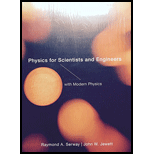
(a)
The kinetic energy of the muon.
(a)
Answer to Problem 61P
The kinetic energy of the muon is
Explanation of Solution
A pion at rest decays to a muon and an antineutrino. The reaction for the decay is shown below.
Here,
The decay reaction obeys both energy conservation law and momentum conservation law. That is energy and momentum of the particles before and after the decay remains the same.
Write the expression for the energy of pion at rest.
Here,
After decay of pion, muon and antineutrino are formed.
Write the expression for the relativistic energy of muon.
Here,
Write the expression of the energy of antineutrino.
Here,
Pion is at rest. So its momentum is zero. Thus the final momentum also should be zero. Thus sum of momentum of muon and antineutrino is equal to zero.
Here,
Write the expression for the momentum of muon.
Here,
Use expression (V) in (IV).
Use expression (VI) in (III) to find
By conservation of energy, energy of pion is equal to the sum of energy of muon and antineutrino.
Use expressions (VII), (II), and (I) in expression (VIII).
Solve expression (IX) for
Write the expression for Lorentz factor.
Use expression (XI) in (X).
Reduce expression (XII).
Solve the right hand side of expression (XIII).
Use expression (XIV) in (XIII).
Write the expression for kinetic energy of muon.
Here,
Conclusion:
Substitute
Substitute
Substitute
Therefore, the kinetic energy of the muon is
(b)
The energy of the antineutrino in electron volts.
(b)
Answer to Problem 61P
The energy of the antineutrino is
Explanation of Solution
Write the expression for the kinetic energy of antineutrino.
Here,
Use expression (I), and (II) in expression (XVII) to find
Substitute
Conclusion:
Substitute
Therefore, the energy of the antineutrino is
Want to see more full solutions like this?
Chapter 39 Solutions
Physics For Scientists And Engineers With Modern Physics, 9th Edition, The Ohio State University
- 20. Two small conducting spheres are placed on top of insulating pads. The 3.7 × 10-10 C sphere is fixed whie the 3.0 × 107 C sphere, initially at rest, is free to move. The mass of each sphere is 0.09 kg. If the spheres are initially 0.10 m apart, how fast will the sphere be moving when they are 1.5 m apart?arrow_forwardpls help on allarrow_forwardpls help on thesearrow_forward
- pls help on all asked questions kindlyarrow_forwardpls help on all asked questions kindlyarrow_forward19. Mount Everest, Earth's highest mountain above sea level, has a peak of 8849 m above sea level. Assume that sea level defines the height of Earth's surface. (re = 6.38 × 106 m, ME = 5.98 × 1024 kg, G = 6.67 × 10 -11 Nm²/kg²) a. Calculate the strength of Earth's gravitational field at a point at the peak of Mount Everest. b. What is the ratio of the strength of Earth's gravitational field at a point 644416m below the surface of the Earth to a point at the top of Mount Everest? C. A tourist watching the sunrise on top of Mount Everest observes a satellite orbiting Earth at an altitude 3580 km above his position. Determine the speed of the satellite.arrow_forward
- pls help on allarrow_forwardpls help on allarrow_forward6. As the distance between two charges decreases, the magnitude of the electric potential energy of the two-charge system: a) Always increases b) Always decreases c) Increases if the charges have the same sign, decreases if they have the opposite signs d) Increases if the charges have the opposite sign, decreases if they have the same sign 7. To analyze the motion of an elastic collision between two charged particles we use conservation of & a) Energy, Velocity b) Momentum, Force c) Mass, Momentum d) Energy, Momentum e) Kinetic Energy, Potential Energyarrow_forward
- pls help on all asked questions kindlyarrow_forwardpls help on all asked questions kindlyarrow_forward17. Two charges, one of charge +2.5 × 10-5 C and the other of charge +3.7 × 10-6 C, are 25.0 cm apart. The +2.5 × 10−5 C charge is to the left of the +3.7 × 10−6 C charge. a. Draw a diagram showing the point charges and label a point Y that is 20.0 cm to the left of the +3.7 × 10-6 C charge, on the line connecting the charges. (Field lines do not need to be drawn.) b. Calculate the net electric field at point Y.arrow_forward
 Modern PhysicsPhysicsISBN:9781111794378Author:Raymond A. Serway, Clement J. Moses, Curt A. MoyerPublisher:Cengage Learning
Modern PhysicsPhysicsISBN:9781111794378Author:Raymond A. Serway, Clement J. Moses, Curt A. MoyerPublisher:Cengage Learning University Physics Volume 3PhysicsISBN:9781938168185Author:William Moebs, Jeff SannyPublisher:OpenStax
University Physics Volume 3PhysicsISBN:9781938168185Author:William Moebs, Jeff SannyPublisher:OpenStax Physics for Scientists and Engineers: Foundations...PhysicsISBN:9781133939146Author:Katz, Debora M.Publisher:Cengage Learning
Physics for Scientists and Engineers: Foundations...PhysicsISBN:9781133939146Author:Katz, Debora M.Publisher:Cengage Learning Physics for Scientists and Engineers with Modern ...PhysicsISBN:9781337553292Author:Raymond A. Serway, John W. JewettPublisher:Cengage Learning
Physics for Scientists and Engineers with Modern ...PhysicsISBN:9781337553292Author:Raymond A. Serway, John W. JewettPublisher:Cengage Learning College PhysicsPhysicsISBN:9781938168000Author:Paul Peter Urone, Roger HinrichsPublisher:OpenStax College
College PhysicsPhysicsISBN:9781938168000Author:Paul Peter Urone, Roger HinrichsPublisher:OpenStax College Physics for Scientists and Engineers, Technology ...PhysicsISBN:9781305116399Author:Raymond A. Serway, John W. JewettPublisher:Cengage Learning
Physics for Scientists and Engineers, Technology ...PhysicsISBN:9781305116399Author:Raymond A. Serway, John W. JewettPublisher:Cengage Learning





